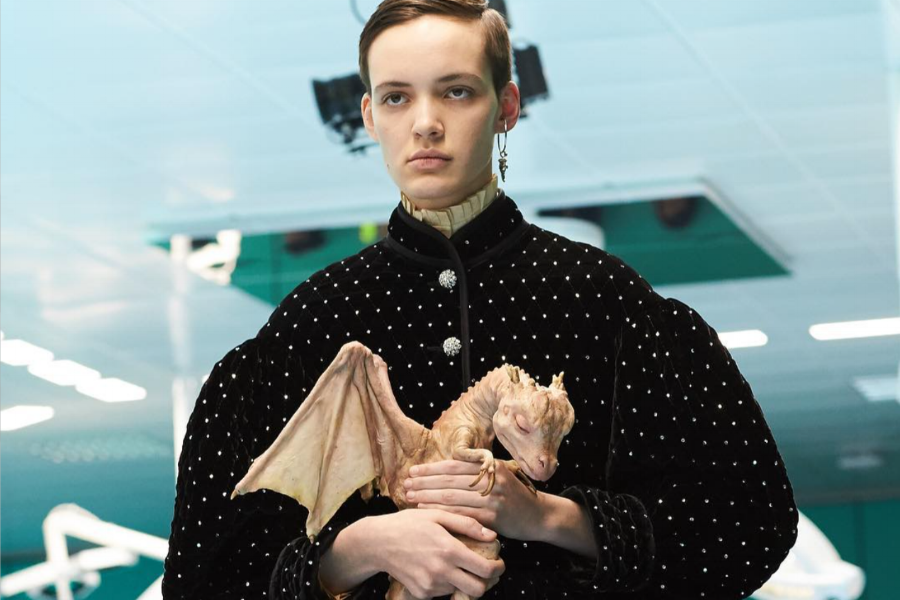
image: Gucci
Fashion’s overarching penchant for theatrics has been the elephant (or in designer Junko Shimada’s case, the giraffe, lion and zebras) in the room in recent seasons. While it is hardly a secret that fashion shows have long been about more than just garments and accessories, this is something that designers are going to great lengths to remind us of in light of the ever-growing number of fashion brands on the fashion month calendar and the growing need to up the ante in terms of theatrics in order to make waves on Instagram, where fashion, on its own, is oftentimes just not enough to break through the tedium of algorithm-ordered timelines.
With an increasing number of brands unabashedly vying for placement on show-goers’ social media accounts, Chanel is no longer the only brand demonstrating over-the-top antics (Remember the Chanel rocket ship? How about the makeshift beach?). Whether it is drones carrying bags (that happened at D&G recently) or models carrying puppies (courtesy of Tod’s), dragon babies (Gucci), actual babies, or models carrying models of their own heads (again, Gucci), fashion month is routinely rife with over-the-top PR antics and politically-charged statements (Dior’s Maria Grazia Chuiri is still at it).
Brands like Balenciaga – which set up a makeshift hotline for show-goers to call, the number was displayed on shirts that went down the runway for F/W 2018; Calvin Klein, which covered the floor of the American Stock Exchange with 50,000 gallons of popcorn; and Burberry, with its rainbow-hued laser light show – are obviously courting the fashion pack’s many, many Instagram users during their shows.
Diesel skipped its show altogether not too long ago in favor of staging a makeshift “counterfeit”-selling pop up shop on Canal Street, a notorious New York haven for fake luxury goods, whereas Moncler showed eight different collections – after tapping Craig Green, Pierpaolo Piccioli and Simone Rocha, among others – as part of its “Genius” project. Prada enlisted computer-generated influencer Lil’ Miquela to take over its Instagram account, and Virgil Abloh invited 16 immigrant soccer players to the Off-White show.
But as many brands continue to up the ante, some have grown tired of (and in some cases, more vocal) about the circus. Giorgio Armani, for instance, spoke out on the heels of Gucci’s runway show, saying that he is “perplexed” by fashion’s antics. “No, I don’t want to be a part of this. Fashion can’t be a means to have the media talk about you.” The 83-year old fashion stalwart further stated, “I have never wanted to trick consumers, and what I show on the runway is what customers can find in stores,” a motto to which Belgian design force Dries Van Noten also abides.
But the piece of the equation that Mr. Armani is not mentioning is that many, many big brands – like Gucci, for instance, the house to which he was most likely referring with his comments, per WWD – do not necessarily employ that same model. In fact, runway garments are widely considered to be a “marketing expense” for most fashion brands, something to which everyone from the late Pierre Berge to Tom Murry, the former CEO of Calvin Klein, have attested.
Brands show over-the-top runway shows as a means of building hype (or prestige) which they can translate to sales of accessible wares, such as commercially-minded garments, and more affordable, often-licensed goods, such as eyewear or bags (a practice that we explored at length here). In furtherance of that model, one the depends on sales volume, social media impressions are a metric of success.
Considering that the vast majority of brands – excluding Dries Van Noten and co., and younger, licensing deal-devoid brands (the ones that really do rely on the sales of runway garments and accessories) – never manufacture or sell any significant portion of the garments that appear on their runways, and with the growing extent of fashion’s reliance on PR stunts in mind, the natural conclusion of all of this really quite simple.
The vast majority of runway collections are only as successful as the number of impressions they receive, and 3D-printed severed heads drive impressions, which, in turn, lead to the sale of a lot of bags and eyewear and fragrances.











